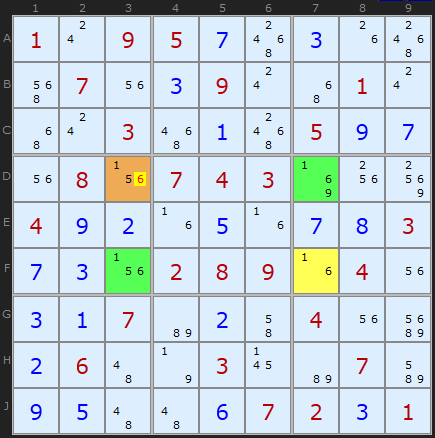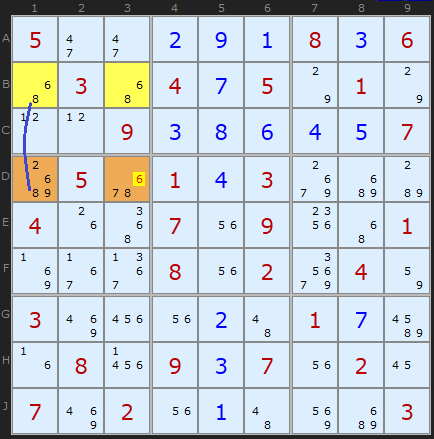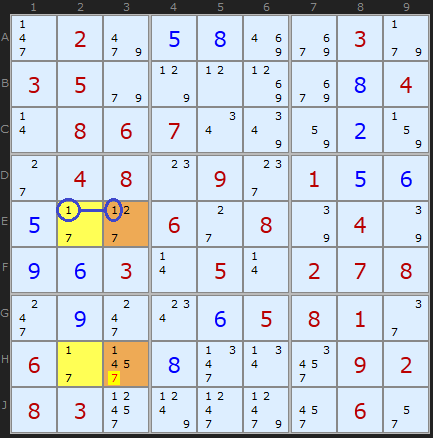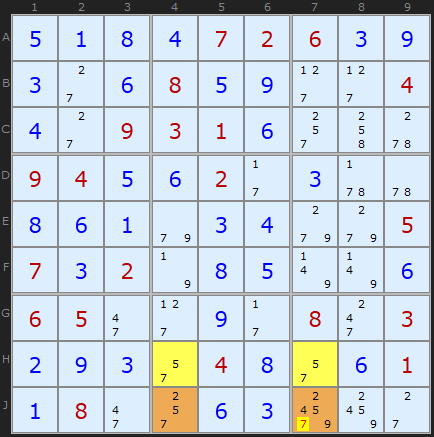Hidden Unique Rectangles
All the Unique Rectangles discussed on this page have had at least two bi-value cells (or a Naked Pair, if you like). An interesting situation emerges when we have only one bi-value cell and the Unique Rectangle is buried, or 'hidden', under lots of other candidates. The conditions have to be just right, but this formation is surprisingly common.

The types of Unique Rectangles that we've examined so far simply won't work here. However, all is not lost because something interesting is going on in the corner opposite to F7. 1 in D3 is part of two strong links in the row and column - that is, 1 occurs only twice in row D and column 3. Our 1 in this rectangle can have only one of two possibilities.
Looking at D3, lets make "Option A" the case where D3 is 1. The pairs or "strong links" remove 1 from in D7 and F3. Option B is where D3 is not a 1. That would put a 1 in D7 and F3.
Let us conjecture that the solution to D3 is 6. That forces the 1s to take on option B because they would be the only remaining 1s in that row and column (D7 and F3). The implication of this option is that the only candidate for F7 is 6. But, wait a moment - this is exactly the deadly pattern we need to avoid - two numbers in two rows, two columns and two boxes. Since none of these cells is a clue, the puzzle could have two solutions. We can swap the 1 and the 6 around. This makes option B unviable.
So surely we can fix the 1s in D7 and F3? Not quite. We haven't taken into account the clutter of other clues in the corners of this rectangle. But we can say something about the 6 in D3. We've excluded it for the reason above, but option A also excludes the 6 in D3. Whichever way round F7 is, D3 cannot contain a 6, so we can remove it from that cell.
So surely we can fix the 1s in D7 and F3? Not quite. We haven't taken into account the clutter of other clues in the corners of this rectangle. But we can say something about the 6 in D3. We've excluded it for the reason above, but option A also excludes the 6 in D3. Whichever way round F7 is, D3 cannot contain a 6, so we can remove it from that cell.
Type 2 Hidden Unique Rectangles

Type 2 starts with a Naked Pair, 8/6, and we're checking for which strong links exist on the pair candidates. The Naked Pair is obviously a double strong link on both numbers, but candidate 8 has a strong link to the Roof in column 1. From this we can start using the logic of Type 1.
Is 6 viable for either Roof Cells? D1 is viable since D3 does not have to be a 8. However, D3 as 6 is trouble because it forces B3 to be 8, B1 to be 6 and because of the strong link, D1 becomes 8. A Deadly Pattern, so it is safe to remove 6 from D3. At first glance the formation looks symmetrical but its the other 6s and 8s (or lack of) in the columns that give us the implications of the Hidden Rectangle.

Up to 2024 I was a little too restrictive with the pattern - particularly if there are two strong links operaing on two candidates at the same time allowing two eliminations. Thanks to David Hollenberg for this example.
Hidden Unique Rectangle
Type 2: removing 4 at G8 because of GJ58 and one strong link on 1 between J5 and J8
Type 2: removing 1 at J8 because of GJ58 and one strong link on 4 between G5 and G8
Type 2b Hidden Unique Rectangles

The yellow cells are the floor with conjugate pairs 1/7. The Deadly Rectangle extends to E3 and H3 (orange) where 1 and 7 are also present among other candidates. The strong link on 1 between E2 and E3 means that a 7 in H3 would create a Deadly Rectangle.
Thanks to Jerry Foil of Virginia, USA for providing the first example. Interestingly this type of Hidden Unique Rectangle is almost twice as common as the Type 1 and three times as common as Type 2.

Klaus Brenner in Germany has created some very beautiful Sudokus like the one on the right. It solves trivially up to the point where a Type 1, Type 2 and Type 2b are used consecutively. In the screen shot the Type 2B is shown with the floor in row H.
HIDDEN UNIQUE RECTANGLE Type 2b: removing 7 at J7 because of HJ47 and one strong link between H4 and J4 on 5

Comments
Email addresses are never displayed, but they are required to confirm your comments. When you enter your name and email address, you'll be sent a link to confirm your comment. Line breaks and paragraphs are automatically converted - no need to use <p> or <br> tags.
... by: Tuan Duong
... by: sunshine 48
Nice job Andrew, thank you.
... by: Camillo
[Last line of the 6th paragraph.]
Regards
... by: Andrew Stuart
... by: Thesty
so we're looking at the paragraph that begins 'Let us conjecture'. it explains that if you put a 5 in H6 then that forces 9s into H4 and B6 and thus a 5 into B4. that array of 5s and 9s forms the deadly pattern i.e. if that were right then the final grid would have an alternative solution (with those 5s and 9s reversed). thus the 5 can't go in H6.
what do you think?
... by: Otto
... by: Dean
... by: Don